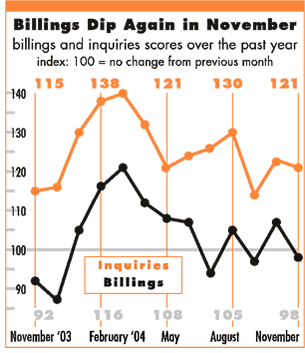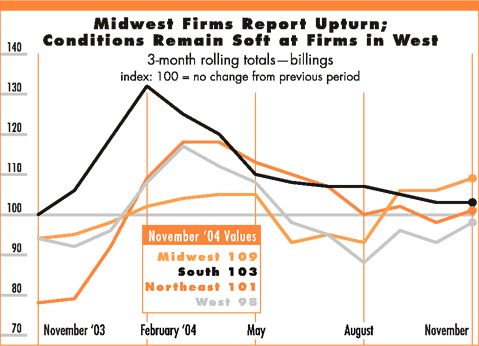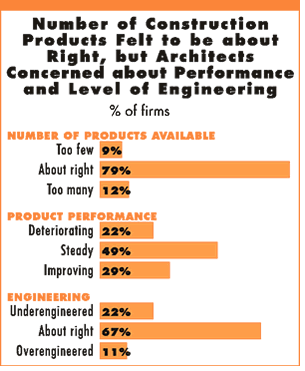

Another Soft Month in
November for Architecture Firms
Architects generally content with number of available construction products;
performance gets mixed review

by Kermit Baker,
PhD, Hon. AIA
Chief Economist
 The up-and-down pattern of business conditions
at U.S. architecture firms continued in November, with billings declining
slightly compared to October levels, but inquiries for new work remaining
strong. Firm billings have been erratic since midyear.
The up-and-down pattern of business conditions
at U.S. architecture firms continued in November, with billings declining
slightly compared to October levels, but inquiries for new work remaining
strong. Firm billings have been erratic since midyear.
Both residential and commercial/industrial firms reported solid billings gains and strong inquiries numbers in November. However, institutional firms reported unusual weakness as fewer than 10 percent of firms specializing in this sector reported an increase in billings, while 30 percent reported declines. Billings were off slightly at firms with a mixed practice, but their inquiries for new work were very strong.
Regionally, firms in the Midwest reported solid gains in November, while firms in the Northeast and South held steady. The slide continued for firms in the West, which have seen a steady slowdown since June.

Volatile economy
The broader economy seems every bit as inconsistent as business conditions
at architecture firms. Even with the GDP numbers in the 4–5 percent
range for the past several quarters, larger sectors in the economy
have been volatile. Payroll employment saw only a small gain of 112,000
jobs in November, after recording an increase of 303,000 jobs in October.
Through the first 11 months of the year, national payrolls are up just
over 2 million, so 2004 will come in as a good—not great—year
for job gains.
Businesses report mixed results. Retail sales in the economy were up almost 7 percent in the third quarter and almost 8 percent so far in the fourth quarter, but corporate profits fell in the third quarter. Business confidence declined again in the third quarter, according to the Conference Board’s CEO Business Confidence Survey. Consumers, however, remain more optimistic. Consumer sentiment readings increased slightly in November, according to the University of Michigan’s survey, and are continuing to move up in December, according to their preliminary reading for this month.
 Construction product trends
Construction product trends
This month we asked our national panel of architecture firms to comment
on trends they were seeing in construction products. Almost 8 in
10 firms feel that there are about the right number of products available
on the market. Residential architects were more likely to feel that
there are too many products available, while commercial/industrial
firms are more likely to feel that there are too few.
However, over 20 percent of firms feel that the performance of products is deteriorating, while almost 30 percent feel that they are improving. Only slightly more than half of firms feel that the availability of technical information for product support is about right, with the rest equally divided between those feeling that there is too little information available, and those feeling that there is too much.
About two thirds of respondents feel that products are appropriately engineered, with 22 percent feeling that they are under-engineered, and 11 percent feeling products are generally over-engineered. Respondents generally agree as to the performance of branded construction products in comparison to generics; 48 percent feel that they generally superior, while 46 percent feel that they are about the same. Only 6 percent felt branded products generally underperform generics.
Copyright 2004 The American Institute of Architects.
All rights reserved. Home Page ![]()
![]()
 |
||
| This month, Work-on-the-Boards survey participants are saying: • Conditions are improving but demands for speed are relentless. • Price of construction escalating without restraint. • There seems to be an abundance of work via referrals.
We find that we are responding to fewer RFQs or RFPs. • Monthly billings have been erratic this year with more
small projects than large, which increases the number of projects
but lowers efficiency and productivity.
|
||